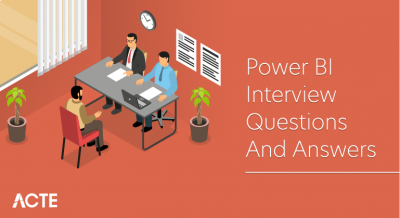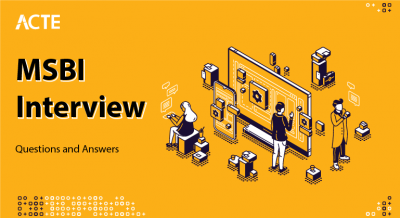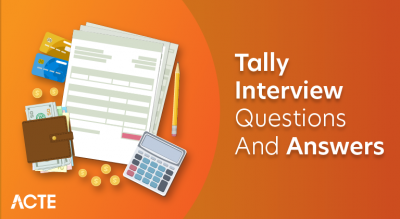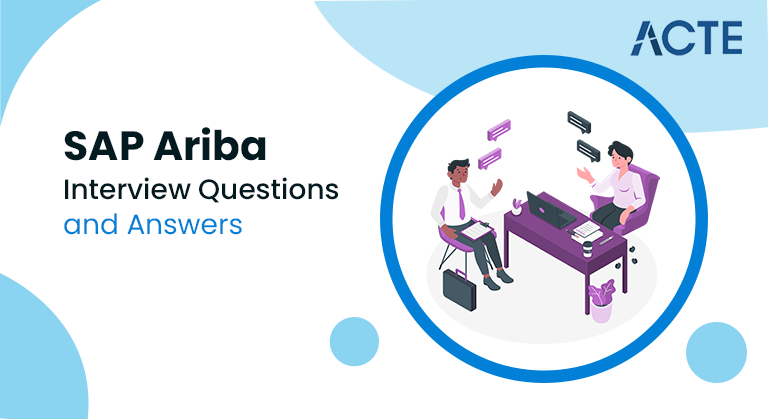
We have assembled the most commonly asked SAP Ariba Interview Questions and Answers will assist you to prepare for the SAP Ariba viva questions and answers that an interviewer might ask you during your interview. In this list of SAP Ariba basic interview questions, we have included all regularly asked basic and SAP Ariba interview questions for experienced candidates with detailed answers to help you clear the job interview. The following list includes best important SAP Ariba programming questions for freshers as well as SAP Ariba questions and answers for experienced programmers to help them prepare for the interview. This complete guide of SAP Ariba interview questions will encourage you to crack your Job interview easily.
1. What is the Ariba Network?
Ans:
The Ariba Network is an online network that includes ordering, payment processing, sourcing, and catalogue provisioning, among other purchasing techniques. Concurrently, Ariba assumes control of the online marketplace, presently linking more than 3.1 million business partners. The marketplace function describes the process of looking for new suppliers and business partners in addition to potential customers for purchases.
2. What is the Difference Between SAP SRM, SAP Ariba, and SAP MM?
Ans:
SAP SRM is a professional programme for business buyers that facilitates direct connections between suppliers and consumers. The purchase order is generated as a SAP ECC backend, and the end user may construct carts. SAP Ariba is efficient in outsourcing quotations like our government tender outsourcing and it serves to gather the quoted quotation and process efficiently based on the quotation selected, ECC MM can generate purchase contracts. SAP MM deals with the full material management solutions which involve procurement and inventory management.
3. What is SAP Ariba Start Sourcing?
Ans:
SAP Ariba Start Sourcing is a sourcing-specific module inside the wider SAP Ariba portfolio. It gives businesses the capabilities and tools they need to optimise and streamline their sourcing procedures. Organisations may effectively manage their supply chain and procurement procedures using SAP Ariba, a cloud-based procurement system.
4. How is the Ariba Procurement solution’s budget changed?
Ans:
Budgets are fixed in the Ariba procurement solution by doing the characteristic called Import Budget Adjustments import a task within the Ariba procurement solution, the budget adjustments are possible.
5. What is the Scope Of SAP Ariba?
Ans:
As the procurement and supply chain industry keeps growing the nature of procurement and the supply chain is also changing hand in hand. Advancements in technology and innovation have shortened the life cycle of products, forcing suppliers and procurement functions to transform their approaches. The procurement and supply chain has increased and in the same way, SAP Ariba has also modified. Now it will move beyond delivering savings and process efficiencies.
6. Where Can Ariba Fit In Sap’s Evolving Cloud Strategy?
Ans:
AP Ariba plays a significant role in SAP’s evolving cloud strategy, aligning with the broader trends and goals of SAP’s cloud-centric approach
- End-to-End Procurement in the Cloud
- Digital Transformation and Intelligent Enterprises
- Collaboration and Connectivity
- Industry Cloud Solutions
- Innovation and Emerging Technologies.
7. What is SAP Ariba Sourcing?
Ans:
The goal of SAP Ariba Sourcing is to assist businesses in overcoming challenges related to supplier information management. SAP Ariba Sourcing is a distinct software-as-a-service (SaaS) solution that is used by thousands of organisations worldwide to design and implement competitive best-value agreements. It is the most widely accepted strategic sourcing solution available in the market.
8. What Are The Benefits Of Sap Ariba?
Ans:
With SAP Ariba, users now have an easy, smart, and open way to connect all the systems and stakeholders through the powerful global Ariba Network. Being part of this network allows customers to decrease costs, mitigate risks, and get products to the market thanks to complete solutions such as the integration of sourcing and product design teams, item cost tracking, contract compliance enhancement, supply availability tracking, and assessment, and deduction of excess inventory, among many others.
9. What are Budget checks in the Ariba procurement solution?
Ans:
The budget check is a feature of the Ariba procurement solution; hence, although under default setup, it is not allowed for all customers by default. Following approval of this feature, every purchase made at the client location will have its budget checked by the Ariba procurement software.
10. What is the Ariba business network?
Ans:
This cloud-based B2B marketplace, called the Ariba Network, allows suppliers and buyers to find each other and do business on a single, networked platform. Ariba is the operator and creator of this marketplace.
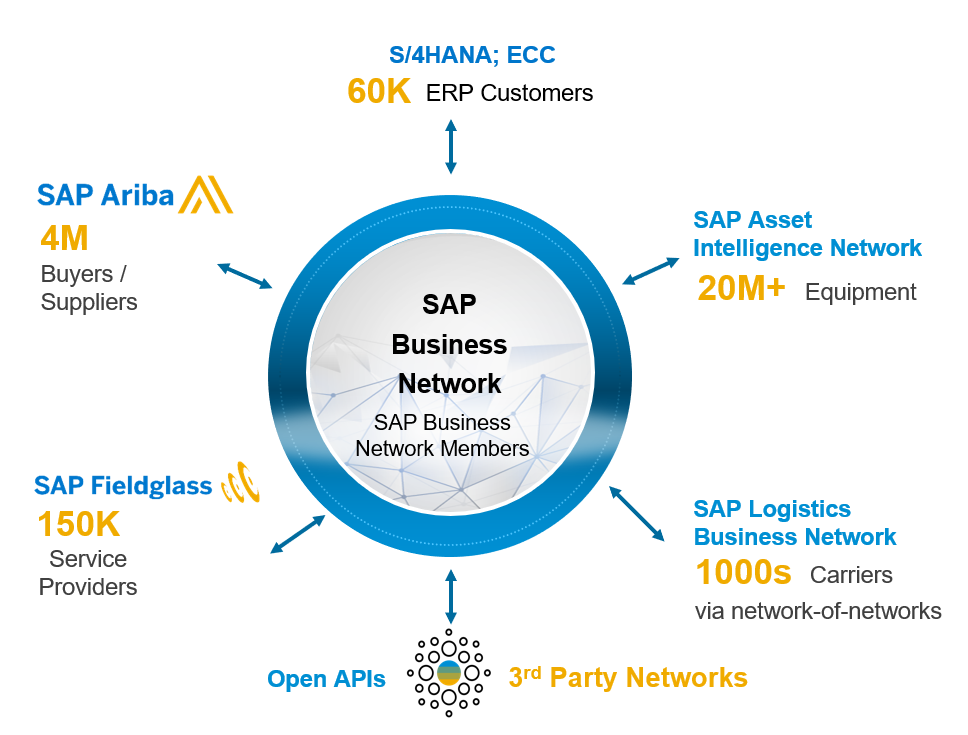
11. Business Benefits of using Ariba Network?
Ans:
- Publish and control access to electronic catalogs
- Respond to business opportunities
- Automate business processes
- Conduct business in secure and reliable environment
- Control and compliance
- One standard process
- Enable increments in sourcing strategy
- Increase loyalty towards preferred suppliers
12. What is SAP Ariba?
Ans:
SAP Ariba is an enterprise software company’s cloud-based procurement platform. SAP Ariba offers a portfolio of procurement and supply chain management tools that help businesses streamline and automate their procurement operations. The platform is intended to bring buyers and suppliers together in a collaborative network, allowing for more efficient and transparent trade.
13. What are the features of SAP Ariba start sourcing?
Ans:
SAP Ariba Start Sourcing is characterized by its communication, subscription-free services, multi-currency support, simplicity in generating and managing RFX, and global, more-lingual capabilities. It also facilitates the supplier profile creation and management.
14. Name the products of the SAP Ariba.
Ans:
SAP Ariba provides the range of products catering to investors and vendors. Investors advantage from contract management, discovery services, and sales catalog management, while vendors are provided with the tools for sourcing, contract management, spending visibility, etc.
15. What is the need for SAP Ariba’s view pitch?
Ans:
SAP Ariba’s view pitch is designed to increase process efficiency, offer simplified connectivity, enhance visibility, and offer timely updates on deliveries, bills, and essential commerce activities.
16. What is Supplier Lifecycle and Performance?
Ans:
SAP Ariba Supplier Lifecycle and Performance (SLP) is a complete solution for managing the whole supplier lifecycle. It includes onboarding, qualification, performance management, and risk reduction. The technology improves openness and efficiency in supplier relationships, allowing organisations to make educated decisions about their vendors.
17. Describe the steps used in the installation of SAP Ariba.
Ans:
The SAP Ariba installation process involves several steps, including system requirements verification, software download, database setup, application installation, and configuration. Post-installation activities include user authentication setup, network configuration, and testing to ensure a seamless deployment.
18. What procedures must be followed in order to install the SAP Ariba network adapter?
Ans:
Installing the SAP Ariba Adapter Network involves steps such as configuring network settings, defining user roles, establishing secure connections, and verifying data transmission protocols. These steps are crucial to enable seamless communication between the SAP Ariba system and external networks
19. What message kinds exist in cXML?
Ans:
cXML (Commerce eXtensible Markup Language) message types are standardized formats for electronic B2B transactions. Common cXML message types include Purchase Order, Order Confirmation, and Invoice. These messages facilitate interoperability between different e-commerce systems, streamlining the exchange of business documents in a structured and consistent manner.).
20. What distinguishes an abstract class from an interface?
Ans:
| Feature | Abstract Class | Interface | |
| Method Types |
Can have abstract and concrete methods. |
Can only have abstract methods. | |
| Instance Variables | Can have instance variables (fields). | Cannot have instance variables (prior to Java 8). | |
| Constructor | Supports constructor overloading. | Does not support constructors (prior to Java 8). |
21. Why do suppliers generate spot bids for Ariba?
Ans:
Vendors create Ariba Spot Quotes to respond quickly to buyer requests for immediate goods or services. It allows them to submit competitive pricing and delivery details on the Ariba Network, facilitating efficient and dynamic procurement processes..
22. Enumerate the different Ariba network adapter files?
Ans:
Various Ariba network adapter files include :
- Ariba Network Adapter for SAP Business Suite,
- Ariba Network Adapter for SAP S/4HANA,
- Ariba Network Adapter for SAP ERP.
- These adapters ensure seamless integration between SAP systems and the Ariba Network.
23. What are the key tactics for suppliers?
Ans:
Essential supplier strategies involve developing strong relationships, ensuring transparent communication, and actively managing risks. It includes supplier segmentation, performance measurement, and collaboration to enhance overall supplier value and minimize potential disruptions.
24. How are ratings for electronic orders managed?
Ans:
- Managing electronic order ratings involves monitoring and analyzing performance metrics related to order fulfillment.
- This includes tracking delivery times, order accuracy, and adherence to specifications. Addressing difficulties as they arise and having open lines of contact with suppliers aid in the optimisation of the computerised order rating process.
25. What are the various ways to transact the business with customers?
Ans:
In-Store Purchases :
Customers visit physical retail locations or brick-and-mortar stores to make purchases directly from the inventory on-site.
E-commerce and Online Shopping :
Customers make purchases through online platforms, websites, or mobile applications, choosing products, adding them to a virtual cart, and completing the transaction online.
26. Distinguish between sourcing and procurement?
Ans:
- Procurement and sourcing are related aspects of the supply chain, but they have distinct focuses.
- Procurement involves the entire process of acquiring goods or services, encompassing sourcing, negotiation, and purchasing.
- Sourcing, on the other hand, specifically refers to the identification and selection of suppliers to obtain goods or services.
27. What’s the finding made by Ariba?
Ans:
Ariba Discovery is a business-to-business online platform provided by SAP Ariba. It connects buyers with suppliers, allowing businesses to discover potential trading partners and streamline the procurement process. The platform facilitates collaboration and communication between buyers and suppliers, promoting efficient and transparent sourcing.
28. What is the purpose of SAP Ariba’s budget check feature?
Ans:
The budget check feature in SAP Ariba is designed to ensure that purchasing transactions align with predefined budgetary constraints. This feature helps organizations control and monitor spending by validating purchase requests against budget limits before approval, preventing overspending and promoting financial discipline.
29. What are the different kinds of SAP Ariba authentications?
Ans:
These include Single Sign-On (SSO), username and password authentication, and multi-factor authentication. SSO enables users to access different apps using a single set of credentials, improving ease and security. Username and password authentication need typical login credentials, but multi-factor authentication provides an extra degree of protection by validating the user’s identity using several verification methods.
30. Describe the Ariba system?
Ans:
The Ariba system, now part of SAP Ariba, is a cloud-based procurement solution that streamlines the source-to-pay process. It encompasses various modules for procurement, sourcing, and supplier management, providing a comprehensive platform for efficient supply chain management.
31. SAP SRM: What is it?
Ans:
- SAP Supplier Relationship Management (SAP SRM) is an integrated procurement solution within the SAP Business Suite.
- It streamlines and automates procurement processes, enhancing collaboration with suppliers.
- SAP SRM covers various procurement activities, including sourcing, procurement planning, and supplier management.
32. SAP MM: What is it?
Ans:
SAP MM, or SAP Materials Management, is a module within the SAP ERP system designed to manage procurement and inventory functions. It encompasses various business processes related to materials, from procurement to payment. SAP MM facilitates the integration of essential tasks such as material planning, purchasing, vendor evaluation, and inventory management.
33. What areas does the SAP cloud application story cover?
Ans:
- Customers
- Suppliers
- Money
- People
34. What is SAP Ariba’s mission?
Ans:
- SAP Ariba’s objective is to improve how organisations manage their procurement operations by encouraging cooperation and creativity throughout the supply chain.
- By leveraging cutting-edge technology, SAP Ariba aims to simplify and optimize procurement, making it more intelligent, connected, and efficient.
- The mission encompasses enabling businesses to achieve better visibility into their supply chain, enhance supplier relationships, and drive sustainable and responsible procurement practices.
35. Why is Spot Quote not looking like it usually does?
Ans:
Spot Quote discrepancies may result from recent changes in the system’s configuration, affecting the appearance and functionality of the spot quoting process. Updates or patches to the quoting software might introduce changes in the user interface or overall appearance, impacting the familiar look of spot quotes. A redesign of the user interface (UI) for spot quoting tools could lead to differences in appearance, offering a refreshed or restructured layout.
36. What are the different SAP Ariba portfolios?
Ans:
- SAP Ariba Invoicing (Financial supply chain).
- SAP Ariba Supplier Management.
- SAP Ariba buying (Procurement).
- SAP Ariba indirect spend (Strategic Sourcing).
- SAP Ariba supply chain (solutions for direct spending).
37. Enumerate the key supplier tactics.
Ans:
- Developing strong supplier relationships,
- Ensuring supply chain resilience,
- Implementing sustainable sourcing practices,
- Embracing innovation from suppliers.
38. Which zones are included in the SAP cloud application?
Ans:
- Vendors
- People
- Investors
- Currency
39. Explain the key modules in SAP Ariba.
Ans:
SAP Ariba includes modules are :
- Procure-to-Pay,
- Strategic Sourcing,
- Supplier Management,
- Contracts.
40. Distinguishes Source-to-Pay (S2P) from Procure-to-Pay (P2P)?
Ans:
Procure-to-Pay (P2P) : P2P primarily focuses on the operational aspects of procurement, covering the entire process from requisitioning goods or services to making the actual payment.
Source-to-Pay (S2P) : Scope: S2P is a broader process that encompasses strategic sourcing and procurement operations, from identifying sourcing opportunities to completing the payment cycle.
41. How does SAP Ariba integrate with SAP ERP systems?
Ans:
SAP Ariba seamlessly integrates with SAP ERP systems through a well-structured and standardized integration approach. Leveraging middleware solutions such as SAP Process Integration or SAP Cloud Platform Integration, organizations establish a robust connection between Ariba and SAP ERP. This integration ensures real-time data synchronization, enabling consistent information flow across both platforms.
42. Explain the concept of dynamic discounting in SAP Ariba.
Ans:
Dynamic discounting in SAP Ariba is a financial strategy that allows buyers to optimize their cash flow by offering suppliers early payment options for invoices. This concept leverages a sliding scale of discounts based on the timing of payment, encouraging suppliers to receive payments sooner in exchange for reduced invoice values. SAP Ariba’s dynamic discounting functionality automates this process, providing a flexible and transparent framework for buyers and suppliers to negotiate discount terms dynamically.
43. How do suppliers and buyers work effectively using Ariba Collaborative Commerce Automation?
Ans:
Ariba Collaborative Commerce Automation fosters effective collaboration between suppliers and buyers by providing a streamlined platform for end-to-end procurement processes. Suppliers can leverage the system to showcase their products or services, submit bids, and respond to requests for proposals. The platform facilitates real-time communication, enabling suppliers to interact with buyers, negotiate terms, and receive timely feedback
44. Which factors are essential for a successful Ariba implementation?
Ans:
SAP Ariba adoption involves thorough planning and consideration of numerous elements to guarantee maximum performance and alignment with organisational goals. To begin, a comprehensive examination of current procurement procedures is essential, as is understanding existing workflows and finding opportunities for improvement.
45. Explain the concept of guided buying in SAP Ariba?
Ans:
SAP Ariba is a concept designed to enhance the procurement experience by providing users with a more intuitive and guided purchasing process. Through guided buying, users are led through a structured and user-friendly workflow, helping them make informed and compliant purchasing decisions. This concept leverages artificial intelligence and machine learning to offer personalized recommendations based on historical purchasing patterns, user preferences, and organizational policies.
46. How does SAP Ariba contribute to sustainable and socially responsible sourcing?
Ans:
SAP Ariba includes features for tracking and evaluating supplier sustainability, enabling organizations to make socially responsible sourcing decisions and align with corporate sustainability goals.
47. What is the Ariba Spot Buy feature?
Ans:
The Ariba Spot Buy feature is a feature of the SAP Ariba procurement solution that enables organisations to make one-time, ad hoc purchases for non-contracted products and services. This feature gives customers access to a curated marketplace of suppliers and products, which offers a diverse choice of commodities that may not be covered by existing contracts.
48. Explain the concept of guided sourcing in SAP Ariba?
Ans:
Guided sourcing in SAP Ariba provides a step-by-step approach to strategic sourcing events, helping users through the creation, management, and completion of sourcing projects.
49. How does a Ariba Supplier Risk Module improve the buying process?
Ans:
Supplier risk variables like as financial stability and compliance are assessed and monitored using the Ariba Supplier Risk module. It enhances procurement processes by helping organizations mitigate risks associated with their supplier base.
50. How does SAP Ariba support the creation and management of contracts?
Ans:
SAP Ariba provides a Contracts module that allows users to create, manage, and collaborate on contracts. It includes features for version control, electronic signatures, and automated contract lifecycle management.
51. Explain Ariba Spend Visibility in procurement analytics?
Ans:
Ariba Spend Visibility aggregates and analyzes procurement data, offering insights into spending patterns and supplier performance. It assists organisations in making educated decisions and identifying cost-cutting options.
52. What is the Ariba Buying and Invoicing (formerly P2O) solution?
Ans:
Ariba Buying and Invoicing is a solution within SAP Ariba that streamlines the procure-to-pay process by integrating purchasing and invoicing functions. It enables efficient order creation, approvals, and invoice reconciliation.
53. How does SAP Ariba enable collaboration between buyers and suppliers in the procurement process?
Ans:
SAP Ariba facilitates collaboration through features like Ariba Network, Supplier Collaboration, and Ariba Collaborative Sourcing. These tools enhance communication, transparency, and efficiency in the buyer-supplier relationship.
54. How does SAP Ariba contribute to compliance and governance in procurement?
Ans:
SAP Ariba supports compliance through features like contract management, policy enforcement, and audit trails. It assists organisations in adhering to regulatory standards as well as internal governance regulations.
55. Explain the concept of Ariba Network and its advantages for both buyers and suppliers.
Ans:
Ariba Network is a platform that links buyers and providers via the cloud.It streamlines transactions, enhances collaboration, and provides real-time visibility into the procurement process, benefiting both parties with increased efficiency and transparency.
56. What is the significance of the Ariba Mobile application in procurement processes?
Ans:
The Ariba Mobile application allows users to manage procurement activities on the go. It provides access to key functionalities, such as approvals and order tracking, enhancing flexibility and responsiveness.
57. How does Ariba Supplier Collaboration enhance communication and collaboration with suppliers
Ans:
Ariba Supplier Collaboration provides a platform for real-time collaboration with suppliers. It allows for joint planning, execution, and issue resolution, fostering a closer and more efficient relationship.
58. Explain the role of Ariba Spot Buy in tactical purchasing.
Ans:
Ariba Spot Buy is used for quick and one-off purchases outside of existing contracts. It streamlines the procurement of goods and services that are not part of regular agreements, providing a more agile buying process.
59. How does Ariba Buying and Invoicing support electronic invoicing and invoice automation?
Ans:
Ariba Buying and Invoicing automates the invoicing process by allowing suppliers to submit electronic invoices directly through the Ariba Network. It streamlines invoice creation, submission, and reconciliation.
60. Explain the benefits of using Ariba Snap for small and medium-sized enterprises (SMEs).
Ans:
Ariba Snap is a streamlined version of SAP Ariba designed for SMEs. It offers simplified procurement capabilities, easy implementation, and a cost-effective solution for smaller organizations to enhance their procurement processes.
61. What are the key benefits of implementing SAP Ariba for an organization?
Ans:
Benefits of SAP Ariba implementation include improved procurement efficiency, enhanced collaboration with suppliers, better visibility into spending, reduced risk, and the ability to make more informed strategic decisions.
62. How does Ariba Collaborative Sourcing contribute to strategic decision-making in procurement?
Ans:
Ariba Collaborative Sourcing promotes collaboration among cross-functional teams during the sourcing process. It enables data-driven decision-making, ensuring that strategic sourcing initiatives align with organizational goals.
63. What is Ariba Catalog solution?
Ans:
SAP Ariba Catalog is a procurement solution that streamlines the purchasing process by providing a centralized platform for managing and accessing product catalogs. This solution allows buyers to browse, search, and purchase goods and services from approved suppliers within a standardized and organized catalog framework. Ariba Catalog simplifies the creation and maintenance of catalogs, enabling suppliers to showcase their products with detailed information, pricing, and images.
64. Explain Ariba Supplier Risk in managing supplier-related risks?
Ans:
Ariba Supplier Risk assesses and monitors supplier-related risks, including financial, geopolitical, and regulatory factors. It helps organizations proactively manage and mitigate potential disruptions in the supply chain.
65. How does SAP Ariba contribute to sustainability in procurement practices?
Ans:
SAP Ariba includes features for tracking supplier sustainability metrics, allowing organizations to make environmentally and socially responsible sourcing decisions. It aligns with corporate sustainability goals and promotes ethical sourcing.
66. How do you plan to migrate data from on-premise procurement systems to SAP Ariba in the cloud?
Ans:
Considerations include data migration, change management, integration with existing systems, and ensuring alignment with business processes. A well-planned migration strategy is crucial for the successful transition.
67. How will Ariba Dynamic Discounting assist in payouts for suppliers and buyers alike?
Ans:
Ariba Dynamic Discounting allows buyers to optimize cash flow by negotiating discounts for early payments. Suppliers benefit by gaining access to accelerated payments, improving their liquidity and financial stability.
68. Explain Ariba Network Cloud Integration and its significance?
Ans:
Ariba Network Cloud Integration involves the seamless connection of SAP Ariba’s cloud-based procurement platform with various enterprise systems, ensuring efficient collaboration between buyers and suppliers. This integration facilitates the exchange of procurement-related information, such as purchase orders, invoices, and supplier details, in real-time.
69. How is the invoicing process made accurate with Ariba Invoice Management?
Ans:
Ariba Invoice Management automates the invoice reconciliation process by matching purchase orders and receipts. This reduces errors, accelerates the approval process, and improves overall accuracy in invoicing.
70. What is Ariba Spot Buy in managing unplanned or urgent procurement needs?
Ans:
Ariba Spot Buy provides a simplified process for quickly acquiring goods or services not covered by existing contracts. It helps organizations respond rapidly to unplanned or urgent procurement requirements.
71. What is Ariba Cloud Integration Gateway (CIG) in SAP Ariba?
Ans:
Ariba CIG facilitates the integration of SAP Ariba solutions with ERP systems. It enables seamless data exchange between Ariba and on-premise or cloud-based ERP systems for a unified procurement process.
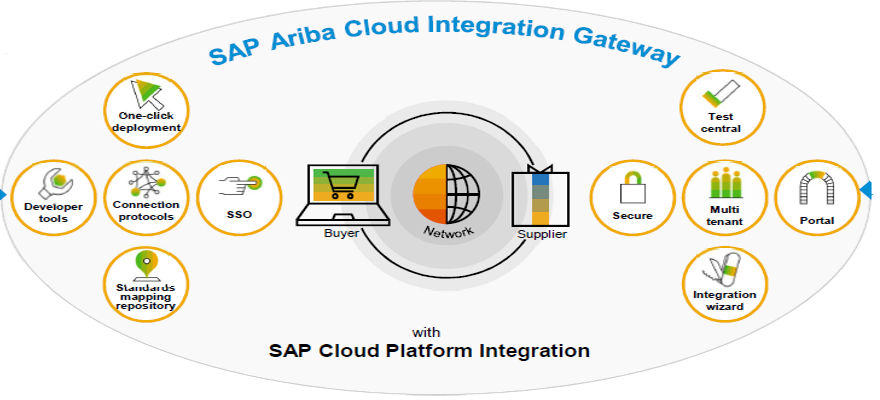
72. How does Ariba Guided Buying contribute to user compliance in procurement?
Ans:
Ariba Guided Buying guides users through the procurement process by presenting preferred suppliers and predefined buying channels. This encourages compliance with organizational policies and ensures adherence to negotiated contracts.
73. What role does Ariba Discovery play in promoting supplier diversity?
Ans:
Ariba Discovery plays a crucial role in promoting supplier diversity by providing a platform that connects businesses with a diverse range of suppliers. The website makes it easier to find vendors who are minorities, women, veterans, or members of other underrepresented groups. Through Ariba Discovery, organizations can actively seek and engage with diverse suppliers, fostering an inclusive and varied supply chain.
74. what way does Ariba Buying and Invoicing help with solving intricate procurement events?
Ans:
Ariba Buying and Invoicing accommodates complex procurement scenarios, including service procurement, by providing tools for managing service orders, milestones, and invoices. It streamlines the end-to-end process for procuring services.
75. Explain Ariba Buying Channels and their significance in procurement?
Ans:
Ariba Buying Channels are predefined purchasing paths that guide users through the procurement process based on their specific needs. They help streamline purchasing for different categories and ensure compliance with organizational policies.
76. How is buying process made efficient by Ariba Catalog Enablement?
Ans:
Ariba Catalog Enablement assists in creating and maintaining electronic catalogs. It ensures that catalogs are accurate, up-to-date, and aligned with procurement needs, enhancing the efficiency of the procurement process.
77. What does Ariba Collaborative Supply Chain play in enhancing visibility of Supply chain?
Ans:
Ariba Collaborative Supply Chain offers real-time visibility into the supply chain by allowing collaboration between buyers and suppliers. It helps with organizations proactively address potential disruptions and optimize supply chain performance.
78. How can organizations leverage Ariba Spend Analysis for strategic decision-making?
Ans:
Ariba Spend Analysis consolidates and analyzes spending data to offer insights into procurement patterns. This information helps organizations make informed decisions, negotiate better contracts, and identify cost-saving opportunities.
79. How does Ariba Network enable global collaboration between buyers and suppliers
Ans:
Ariba Network is a global platform that allows buyers and suppliers to collaborate regardless of geographical locations. It facilitates an efficient communication, transactions, and collaboration in a connected global supply chain.
80. What security measures does SAP Ariba implement to protect sensitive procurement data?
Ans:
SAP Ariba employs an industry-standard security measures, including data encryption, access controls, and regular security audits. Additionally, it provides features like multi-factor authentication to enhance user account security
81. How does Ariba Discount Management help businesses boost their cash flow?
Ans:
Ariba Discount Management helps organisations improve their cash flow by rewarding early payments and optimising working capital. For starters, it enables organisations to negotiate dynamic discount conditions with their suppliers, encouraging them to give early payment reductions. This strategic strategy expedites the accounts payable process, allowing firms to take advantage of early payment incentives and save money.
82. Explain Ariba Network Adapter for SAP ERP ?
Ans:
The Ariba Network Adapter for SAP ERP serves as a vital connector, facilitating seamless integration between SAP ERP systems and the Ariba Network. This adapter acts as a bridge, enabling the exchange of critical procurement and supply chain information between the two platforms. It leverages standardized integration methods, including SAP Process Integration (PI) or SAP Cloud Platform Integration, to ensure smooth communication and data synchronization..
83. How will SAP Ariba handle procurement procedures adhere to industry norms requirements?
Ans:
SAP Ariba has features such as audit trails, policy enforcement, and reporting tools to assist organisations comply with regulatory obligations and industry standards in their procurement activities.
84. Explain Ariba Collaborative Sourcing in managing supplier relationships during the sourcing process?
Ans:
Ariba Collaborative Sourcing fosters collaboration among buyers and suppliers during sourcing events. It helps build stronger supplier relationships by facilitating communication, negotiation, and joint decision-making.
85. What is Ariba Discovery for Buyers, and how does it streamline the supplier discovery process?
Ans:
Ariba Discovery for Buyers allows organizations to post their sourcing needs, and suppliers respond with their offerings. It streamlines the supplier discovery process by connecting buyers with a diverse pool of potential suppliers.
86. What is Ariba Network for Global Trade with Small and Medium-Sized Enterprises?
Ans:
Ariba Network provides SMEs with a platform to participate in global trade by connecting them with a vast network of buyers. It helps SMEs expand their market reach and efficiently engage in cross-border transactions.
87. How does Ariba Collaborative Sourcing contribute to cost savings in procurement processes?
Ans:
Ariba Collaborative Sourcing contributes to cost savings by providing tools for strategic negotiation, bid analysis, and supplier collaboration. It helps organizations secure better deals and optimize their sourcing strategies.
88. Explain Ariba Buying and how it simplifies the buying process for end-users?
Ans:
Ariba Buying provides end-users with a simplified and user-friendly interface for creating purchase requisitions, managing orders, and tracking deliveries. It enhances the user experience and encourages compliance with procurement policies
89. Explain Ariba Snap and its suitability for specific business sizes?
Ans:
SAP Ariba Snap is a simplified and preconfigured procurement solution designed to meet the demands of small and medium-sized organisations (SMEs). Ariba Snap’s streamlined deployment strategy allows firms to improve their procurement operations in a timely and cost-effective manner.
90. What does Ariba Collaborative Supply Chain in inventory management and demand planning?
Ans:
Ariba Collaborative Supply Chain enables collaboration between buyers and suppliers in demand planning and inventory management. It helps optimize stock levels, reduce lead times, and enhance overall supply chain efficiency.



